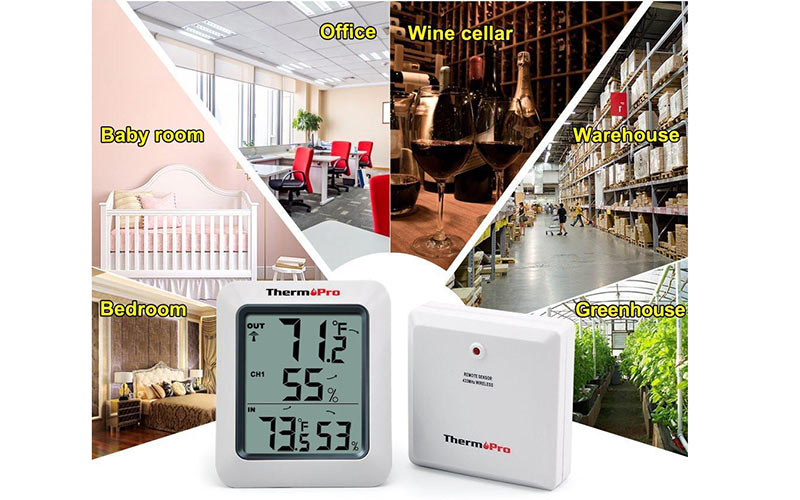The customer service team is always listening, taking notes, and quantifying complaints to ensure our products are continually improved. Due to selling directly to you, the customer, via Amazon, we can use product reviews to help us improve our existing products or help further development of new products.
Where to Put Remote Sensors for Thermometers/Hygrometers
Table of Contents
A hygrometer/thermometer combination unit is a powerful device that helps you set up a comfortable and healthy living space. This is especially true for units that come packaged with remote sensors that extend the functionality of these hybrid products.
Unfortunately, these additional units bring up a new problem. Where do you put them? Get the most out of your living environment by finding out where to put remote sensors for thermometers/hygrometers!
Read this to-the-point guide to maximize your experience with these helpful tools! Learn the best ways to place remote sensors to gain a complete and thorough understanding of your natural environment!
Why Use Indoor/Outdoor Thermometers/Hygrometers?
In an age when the entire Internet fit into your pocket, it seems irrelevant to pay for a weather report that you could look up online. And yet, indoor/outdoor thermometers/hygrometers are not the same as weather reports. These give weather forecasts centralized in city centers or airports. Instead, these devices tell you about current atmospheric conditions, giving you real info that you can use.
Weather reports serve an entire region; they explain probable weather outcomes to a large audience of people. On the other hand, a personal thermometer/hygrometer tells you the current results of a single place – your home or office. By limiting the results to one specific location, you have the ability to determine how to improve your interior environment.
READ: 5 Tips for Using ThermoPro Indoor/Outdoor Thermometers
Is the air too dry? Is the temperature too cold? Instead of depending on your senses, you can know for certain by using measurements based on precise units. Don’t wait for someone else to confirm your suspicions that your home is getting drier. By using a room thermometer/hygrometer, you’ll be able to know how much the temperature or humidity has changed.
And with units that provide measurements from both inside and out, an indoor/outdoor thermometer/hygrometer can be even more useful. These powerful units can provide a comprehensive understanding of the air in and around your home. In this way, these products give you the info you need to make necessary adjustments to your HVAC or other home air system.

The Importance of Remote Sensors for Hygrometers/Thermometers
Some indoor hygrometers/thermometers come packaged as all-in-one varieties. With a single unit, these show the current conditions of your interior environment. However, to gain a better understanding, it’s important to get a thermometer/hygrometer equipped with a remote sensor. These wireless units monitor their immediate surroundings, allowing you to compare different locations and make individual adjustments.
The main benefit of a remote sensor is very clear. Instead of just monitoring the air of the room where its receiver is placed, a hygrometer/thermometer equipped with a remote sensor allows you to choose where to prioritize. Better still, remote sensors are often designed for outdoor use, expanding the number of available locations to test.
Knowing the conditions for the temperature and humidity of your home or office can go a long way in optimizing your comfort and health. In this way, remote sensors for hygrometers/thermometers help extend their functionality, making for a wise purchase that serve a wide range of purposes.

Where to Place a Remote Sensor Outside
An outdoor temperature sensor is very useful for getting to know the precise atmospheric conditions of the air outside your home or office. Best of all, you don’t even have to go outside! As these are delicate instruments, these exterior temperature sensors can’t just be put anywhere. As such, they require specific conditions that dictate their placement.
READ: Where is the Proper Place to Put an Outdoor Thermometer
Remote Sensor Placement Guidelines
To make sure you get the best results for your home hygrometer/thermometer, please follow these guidelines:
- Proper Airflow: An outside temperature sensor is completely dependent on a proper airflow to provide accurate results. The sensor should be placed in an area where air moves freely, and not in an area sheltered from airflow or at the base of an incline. In effect, any blockage of air to the remote sensor will cause the instruments to give false readings.
- Avoid Direct Sunlight: Put your outdoor weather sensor in the shade and out of the sun. Direct sunlight will cause the unit to heat up and exceed the temperature of the air around it. Moreover, if your home is in the northern hemisphere, a good location for the sensor could be on the north side of your house.
- Avoid Rain: Make sure your outdoor temp sensor stays out of the rain. Keep it in a covered location that protects it from the elements. Additionally, you could create an enclosure in which to house the remote sensor. However, keep in mind that any enclosure you use needs to provide a steady airflow to allow for accurate measurements.
- Avoid Placing on Your Home: The outside of your home seems like a sensible place to hang your outside air temperature sensor. Unfortunately, heat coming from your home may affect the sensor, causing it to malfunction.
- Avoid Concrete & Pavement: These types of man-made material may lead to overheating on sunny days.
- Away from House: As it were, the best place to put your outside temp sensor is away from your house. According to the National Weather Service (NWS), the ideal location for a remote sensor for a hygrometer/thermometer is 4 times the distance of the height of your home. For example, if your home is 25 feet high, then you should place the remote sensor at least 100 feet away from your house.
- Stay Off the Ground: Place the temperature sensor outside 4-6 feet off the ground to mitigate the influence of ground temperature.

Where to Place a Remote Sensor Inside
The good news is that the conditions for placing a remote sensor inside your home are much less stringent than those for outdoor placement. These include:
- Multiple Placement Options: Both the receiver and the remote sensor have the option of being mounted on a wall or placed on a flat surface.
- Proper Receiver Setup: The receiver should be placed in a well-ventilated indoor area, located away from vents, heating or cooling elements, direct sunlight, windows, doors, or other openings
The possibilities for placing the remote sensor in an indoor location are almost limitless. They all depend on the rooms of your home and may suit just about any location.
READ: 10 Uses for a ThermoPro Hygrometer
Use a remote sensor to monitor interior locations such as:
- Bedroom: Give yourself a pleasant rest by avoiding dry air in your bedroom.
- Nursery: Keep your baby comfortable in the baby room.
- Cellar/Basement: Monitor the temperature & humidity in your basement without ever needing to go there yourself.
- Living Room: Ensure a comfortable living environment in the busiest room of your house.
- Office: Keep productivity high by maintaining a comfortable environment.
- Greenhouse: Maintain ideal growing conditions for your plants.
- Music Room: Make sure wooden instruments stay in shape by maintaining the proper room humidity.
- Pet Room: Maintain the proper environment for exotic pets by monitoring room temp and humidity.
- Storage Room: Avoid complications from mold and dampness by putting an indoor temperature sensor in your storage room.
- Classroom/Study Room: Maintain proper studying conditions by maintaining a comfortable room temperature and humidity.
Final Thoughts
Whether indoors or outside, environmental thermometers/hygrometers are useful devices that allow you to use them just about anywhere. Just remember to follow these guidelines to ensure that you’re using these devices properly. Get the most out of your home with remote sensors for thermometers/hygrometers! Are you looking to improve the comfort of your home environment? Want extended coverage for your indoor/outdoor thermometer/hygrometer? Consider getting the ThermoPro TP60 3-Sensor Digital 500-ft Wireless Indoor/Outdoor Thermometer/Hygrometer. This versatile unit is designed for both inside and outside use and work up to a distance of 500′ with the use of wireless remote sensors. For more outdoor hygrometers or indoor hygrometers, please refer to our store page on ThermoPro.








